Analysis of Management Accounting Practices: Turramurra Furniture
VerifiedAdded on 2020/05/16
|17
|2801
|177
Report
AI Summary
This report provides a detailed analysis of the management accounting practices employed by the Turramurra Furniture Company, a specialist manufacturer of computer furniture. The report addresses seven key questions, starting with an introduction to job order costing and its suitability for the company's product differentiation. It then delves into the work-in-process balance, the cost of chairs in finished goods inventory, and the computation of under or over-applied overhead. The report explores various transactions for adjusting over-applied overheads and the process for adjusting the cost of material. Finally, it discusses the application of Activity Based Costing (ABC) as a potential improvement to the company's overhead allocation methods. The report concludes that while job order costing is effective, ABC could further refine the allocation of overhead costs and improve decision-making. This report is contributed by a student and published on Desklib, a platform providing AI-based study tools.
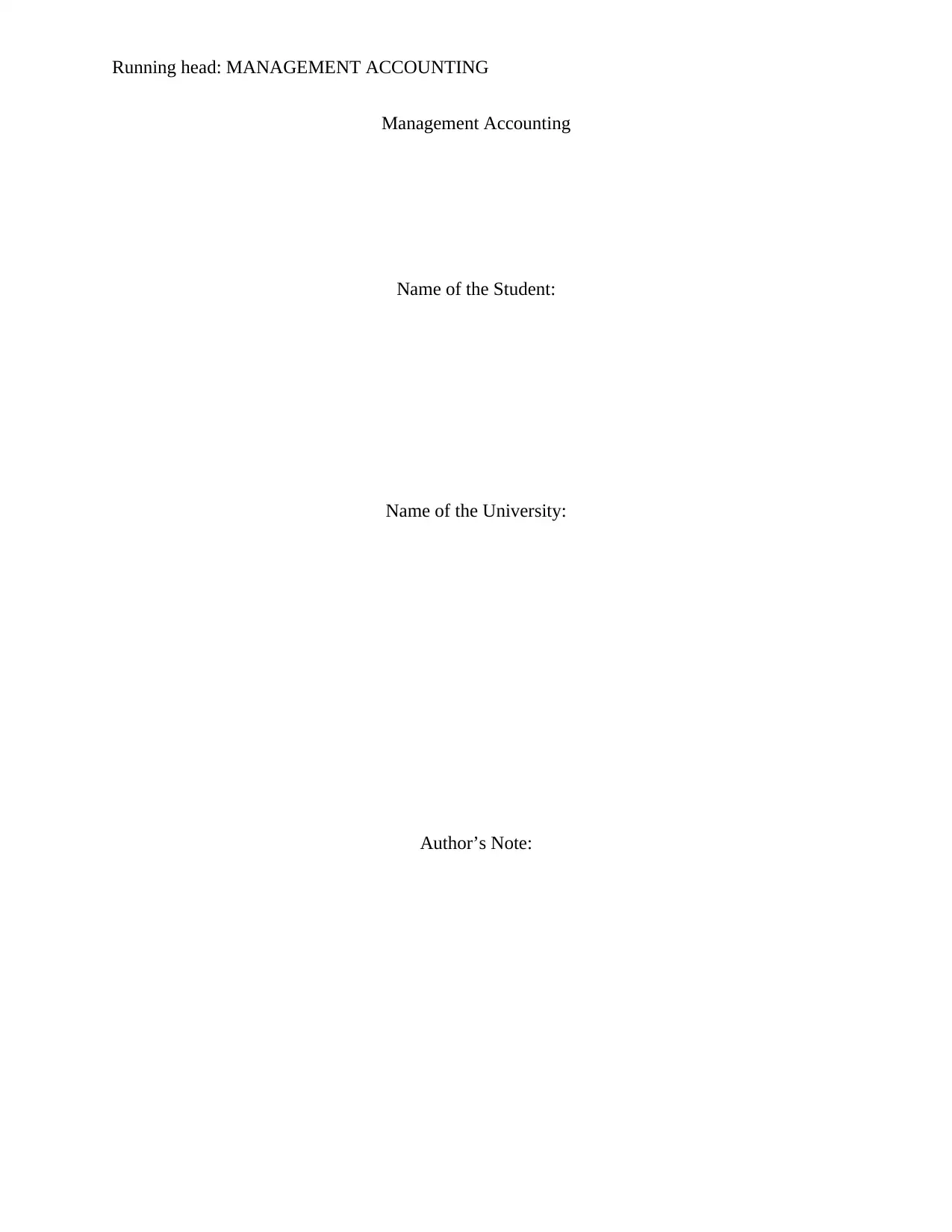
Running head: MANAGEMENT ACCOUNTING
Management Accounting
Name of the Student:
Name of the University:
Author’s Note:
Management Accounting
Name of the Student:
Name of the University:
Author’s Note:
Paraphrase This Document
Need a fresh take? Get an instant paraphrase of this document with our AI Paraphraser
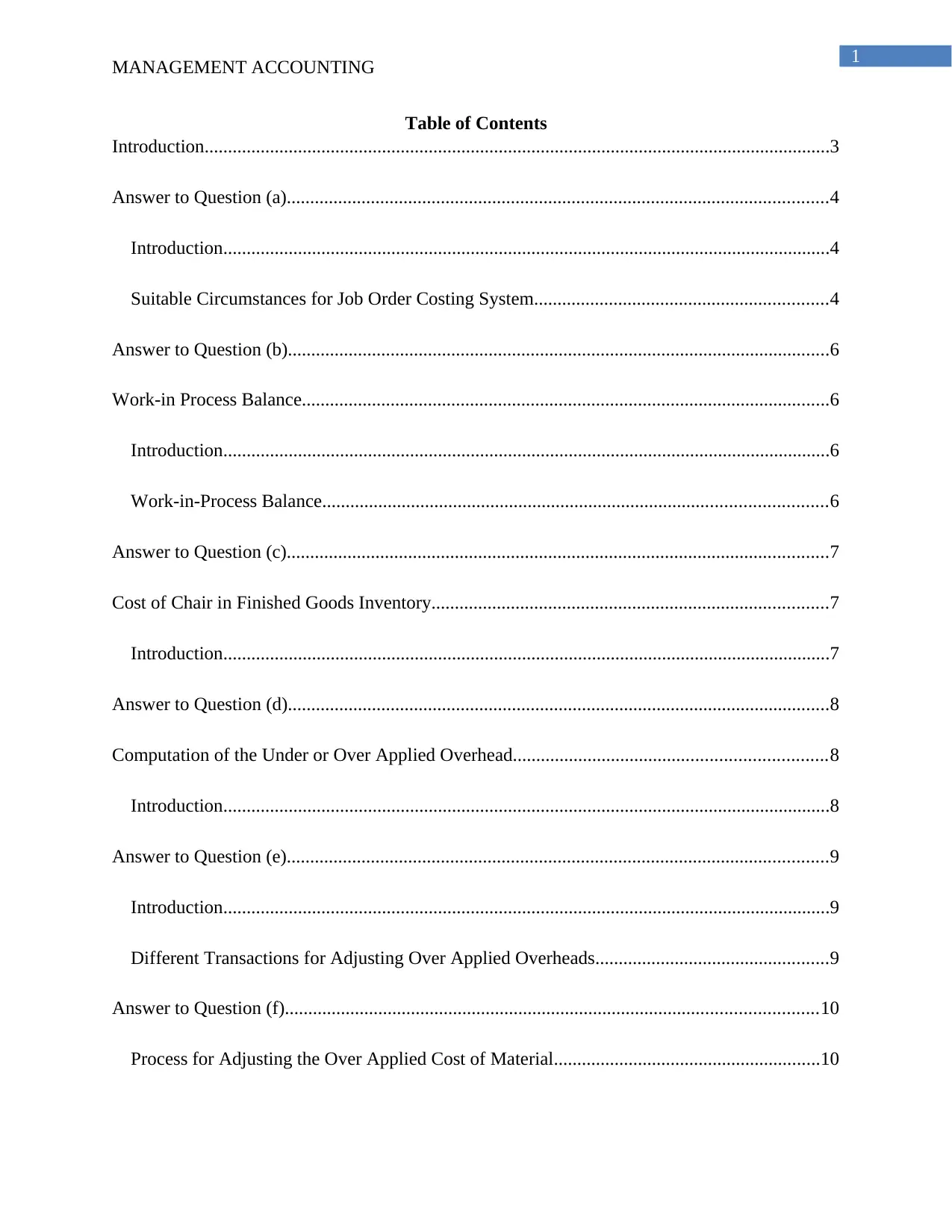
1
MANAGEMENT ACCOUNTING
Table of Contents
Introduction......................................................................................................................................3
Answer to Question (a)....................................................................................................................4
Introduction..................................................................................................................................4
Suitable Circumstances for Job Order Costing System...............................................................4
Answer to Question (b)....................................................................................................................6
Work-in Process Balance.................................................................................................................6
Introduction..................................................................................................................................6
Work-in-Process Balance............................................................................................................6
Answer to Question (c)....................................................................................................................7
Cost of Chair in Finished Goods Inventory.....................................................................................7
Introduction..................................................................................................................................7
Answer to Question (d)....................................................................................................................8
Computation of the Under or Over Applied Overhead...................................................................8
Introduction..................................................................................................................................8
Answer to Question (e)....................................................................................................................9
Introduction..................................................................................................................................9
Different Transactions for Adjusting Over Applied Overheads..................................................9
Answer to Question (f)..................................................................................................................10
Process for Adjusting the Over Applied Cost of Material.........................................................10
MANAGEMENT ACCOUNTING
Table of Contents
Introduction......................................................................................................................................3
Answer to Question (a)....................................................................................................................4
Introduction..................................................................................................................................4
Suitable Circumstances for Job Order Costing System...............................................................4
Answer to Question (b)....................................................................................................................6
Work-in Process Balance.................................................................................................................6
Introduction..................................................................................................................................6
Work-in-Process Balance............................................................................................................6
Answer to Question (c)....................................................................................................................7
Cost of Chair in Finished Goods Inventory.....................................................................................7
Introduction..................................................................................................................................7
Answer to Question (d)....................................................................................................................8
Computation of the Under or Over Applied Overhead...................................................................8
Introduction..................................................................................................................................8
Answer to Question (e)....................................................................................................................9
Introduction..................................................................................................................................9
Different Transactions for Adjusting Over Applied Overheads..................................................9
Answer to Question (f)..................................................................................................................10
Process for Adjusting the Over Applied Cost of Material.........................................................10
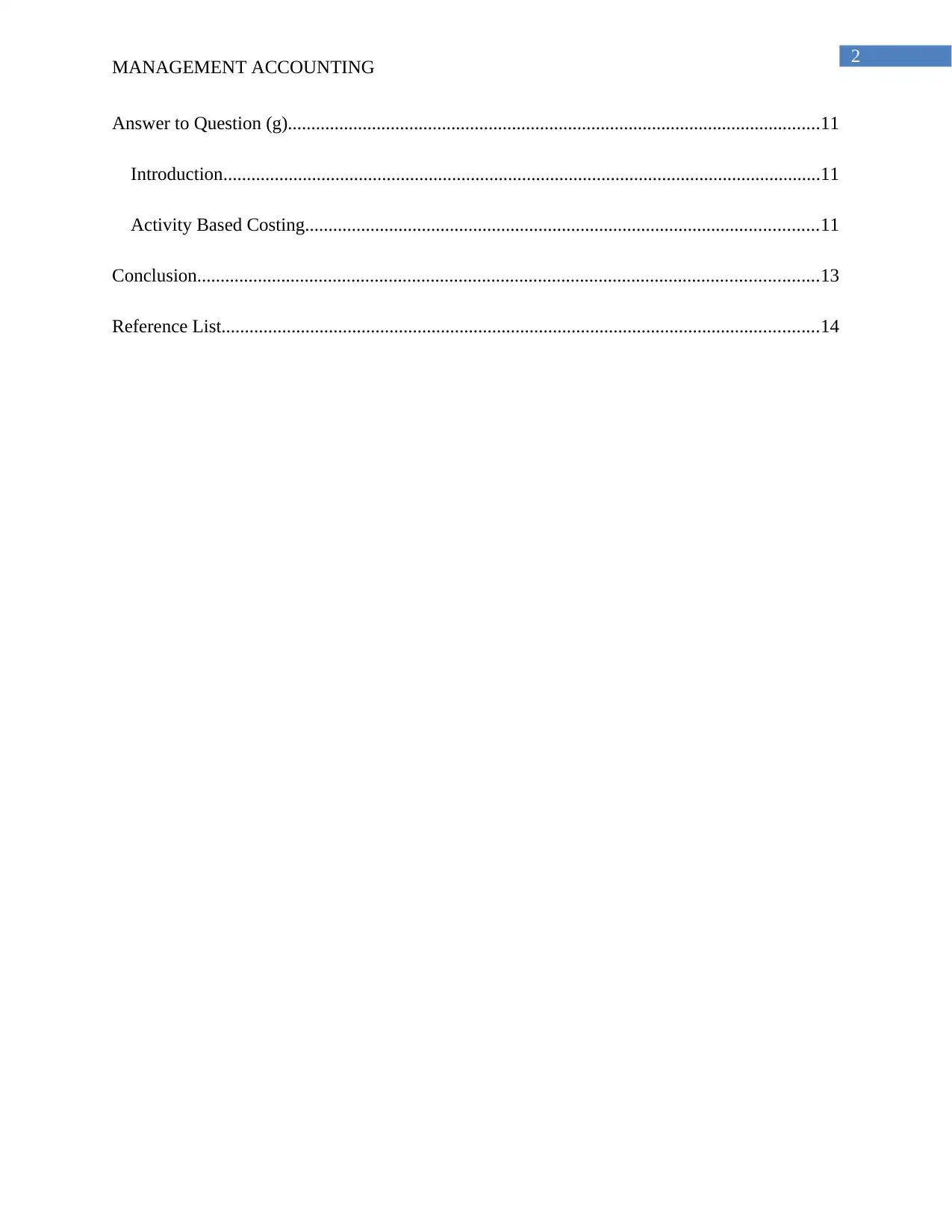
2
MANAGEMENT ACCOUNTING
Answer to Question (g)..................................................................................................................11
Introduction................................................................................................................................11
Activity Based Costing..............................................................................................................11
Conclusion.....................................................................................................................................13
Reference List................................................................................................................................14
MANAGEMENT ACCOUNTING
Answer to Question (g)..................................................................................................................11
Introduction................................................................................................................................11
Activity Based Costing..............................................................................................................11
Conclusion.....................................................................................................................................13
Reference List................................................................................................................................14
⊘ This is a preview!⊘
Do you want full access?
Subscribe today to unlock all pages.

Trusted by 1+ million students worldwide
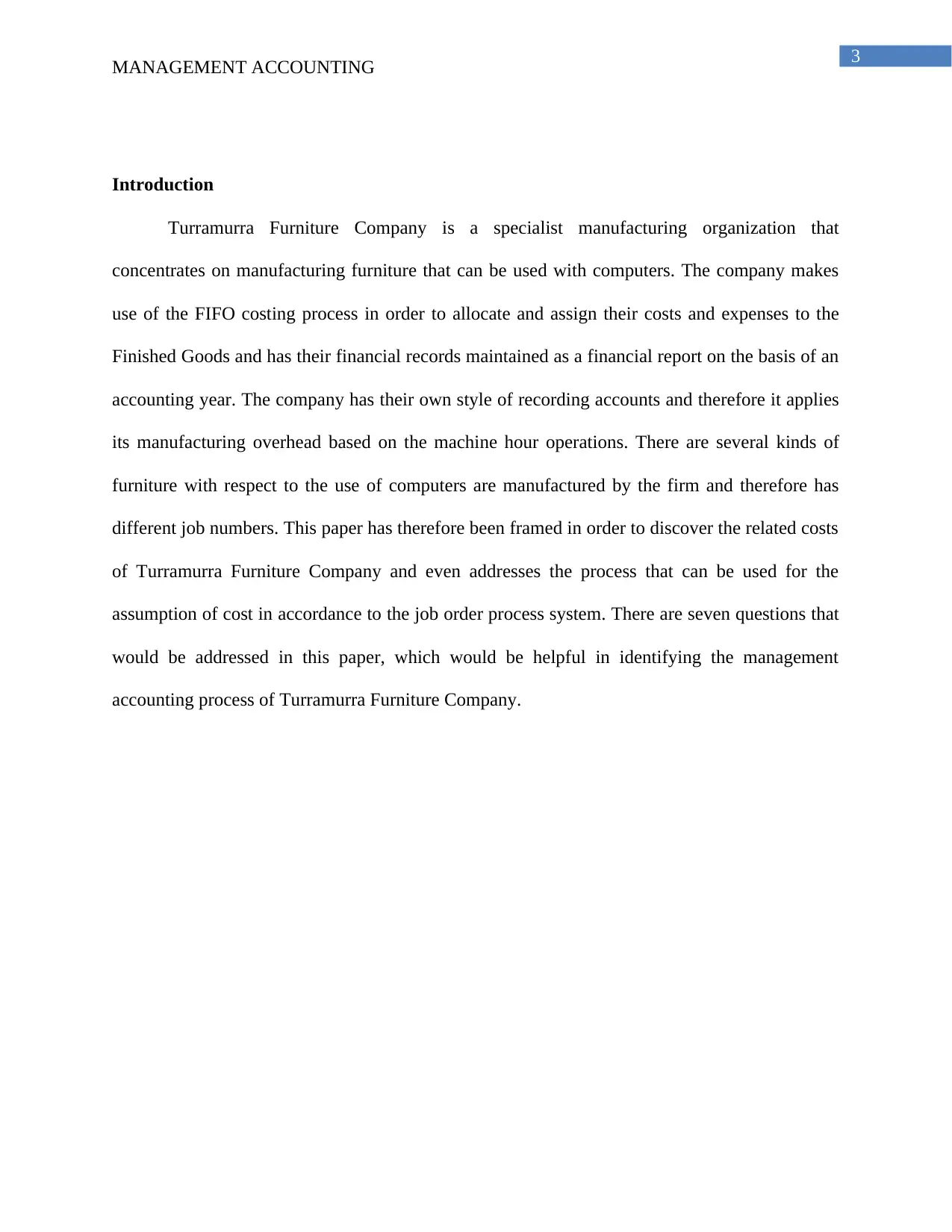
3
MANAGEMENT ACCOUNTING
Introduction
Turramurra Furniture Company is a specialist manufacturing organization that
concentrates on manufacturing furniture that can be used with computers. The company makes
use of the FIFO costing process in order to allocate and assign their costs and expenses to the
Finished Goods and has their financial records maintained as a financial report on the basis of an
accounting year. The company has their own style of recording accounts and therefore it applies
its manufacturing overhead based on the machine hour operations. There are several kinds of
furniture with respect to the use of computers are manufactured by the firm and therefore has
different job numbers. This paper has therefore been framed in order to discover the related costs
of Turramurra Furniture Company and even addresses the process that can be used for the
assumption of cost in accordance to the job order process system. There are seven questions that
would be addressed in this paper, which would be helpful in identifying the management
accounting process of Turramurra Furniture Company.
MANAGEMENT ACCOUNTING
Introduction
Turramurra Furniture Company is a specialist manufacturing organization that
concentrates on manufacturing furniture that can be used with computers. The company makes
use of the FIFO costing process in order to allocate and assign their costs and expenses to the
Finished Goods and has their financial records maintained as a financial report on the basis of an
accounting year. The company has their own style of recording accounts and therefore it applies
its manufacturing overhead based on the machine hour operations. There are several kinds of
furniture with respect to the use of computers are manufactured by the firm and therefore has
different job numbers. This paper has therefore been framed in order to discover the related costs
of Turramurra Furniture Company and even addresses the process that can be used for the
assumption of cost in accordance to the job order process system. There are seven questions that
would be addressed in this paper, which would be helpful in identifying the management
accounting process of Turramurra Furniture Company.
Paraphrase This Document
Need a fresh take? Get an instant paraphrase of this document with our AI Paraphraser
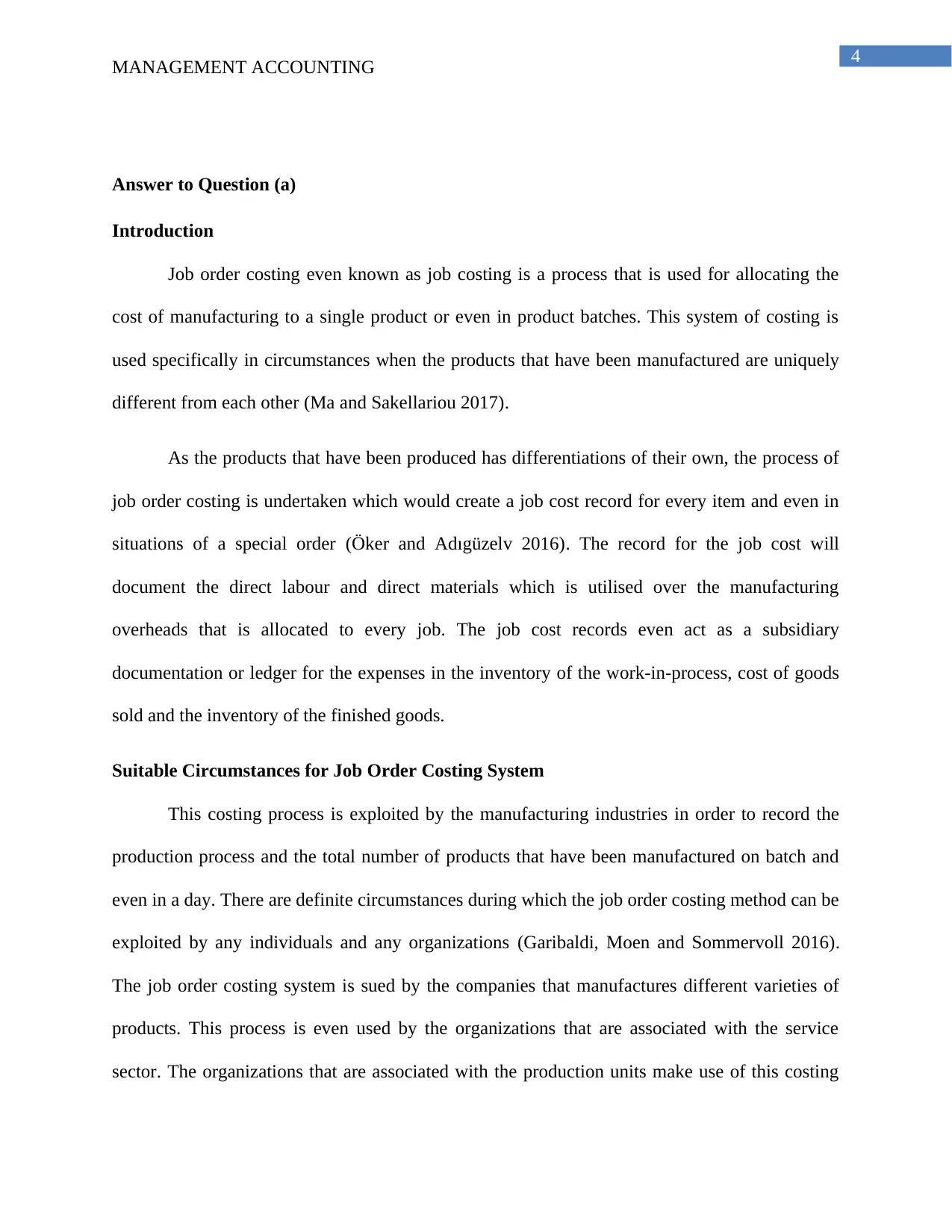
4
MANAGEMENT ACCOUNTING
Answer to Question (a)
Introduction
Job order costing even known as job costing is a process that is used for allocating the
cost of manufacturing to a single product or even in product batches. This system of costing is
used specifically in circumstances when the products that have been manufactured are uniquely
different from each other (Ma and Sakellariou 2017).
As the products that have been produced has differentiations of their own, the process of
job order costing is undertaken which would create a job cost record for every item and even in
situations of a special order (Öker and Adıgüzelv 2016). The record for the job cost will
document the direct labour and direct materials which is utilised over the manufacturing
overheads that is allocated to every job. The job cost records even act as a subsidiary
documentation or ledger for the expenses in the inventory of the work-in-process, cost of goods
sold and the inventory of the finished goods.
Suitable Circumstances for Job Order Costing System
This costing process is exploited by the manufacturing industries in order to record the
production process and the total number of products that have been manufactured on batch and
even in a day. There are definite circumstances during which the job order costing method can be
exploited by any individuals and any organizations (Garibaldi, Moen and Sommervoll 2016).
The job order costing system is sued by the companies that manufactures different varieties of
products. This process is even used by the organizations that are associated with the service
sector. The organizations that are associated with the production units make use of this costing
MANAGEMENT ACCOUNTING
Answer to Question (a)
Introduction
Job order costing even known as job costing is a process that is used for allocating the
cost of manufacturing to a single product or even in product batches. This system of costing is
used specifically in circumstances when the products that have been manufactured are uniquely
different from each other (Ma and Sakellariou 2017).
As the products that have been produced has differentiations of their own, the process of
job order costing is undertaken which would create a job cost record for every item and even in
situations of a special order (Öker and Adıgüzelv 2016). The record for the job cost will
document the direct labour and direct materials which is utilised over the manufacturing
overheads that is allocated to every job. The job cost records even act as a subsidiary
documentation or ledger for the expenses in the inventory of the work-in-process, cost of goods
sold and the inventory of the finished goods.
Suitable Circumstances for Job Order Costing System
This costing process is exploited by the manufacturing industries in order to record the
production process and the total number of products that have been manufactured on batch and
even in a day. There are definite circumstances during which the job order costing method can be
exploited by any individuals and any organizations (Garibaldi, Moen and Sommervoll 2016).
The job order costing system is sued by the companies that manufactures different varieties of
products. This process is even used by the organizations that are associated with the service
sector. The organizations that are associated with the production units make use of this costing
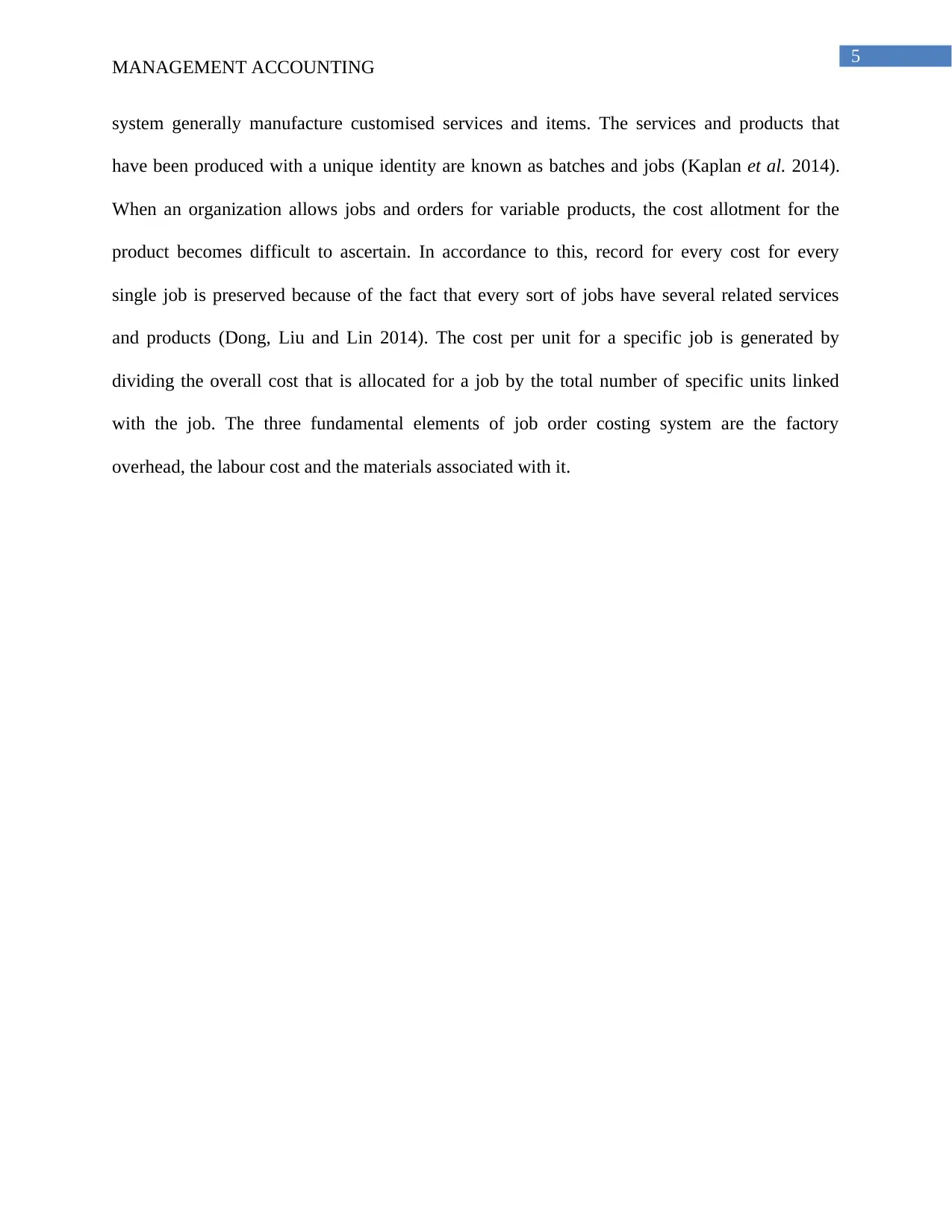
5
MANAGEMENT ACCOUNTING
system generally manufacture customised services and items. The services and products that
have been produced with a unique identity are known as batches and jobs (Kaplan et al. 2014).
When an organization allows jobs and orders for variable products, the cost allotment for the
product becomes difficult to ascertain. In accordance to this, record for every cost for every
single job is preserved because of the fact that every sort of jobs have several related services
and products (Dong, Liu and Lin 2014). The cost per unit for a specific job is generated by
dividing the overall cost that is allocated for a job by the total number of specific units linked
with the job. The three fundamental elements of job order costing system are the factory
overhead, the labour cost and the materials associated with it.
MANAGEMENT ACCOUNTING
system generally manufacture customised services and items. The services and products that
have been produced with a unique identity are known as batches and jobs (Kaplan et al. 2014).
When an organization allows jobs and orders for variable products, the cost allotment for the
product becomes difficult to ascertain. In accordance to this, record for every cost for every
single job is preserved because of the fact that every sort of jobs have several related services
and products (Dong, Liu and Lin 2014). The cost per unit for a specific job is generated by
dividing the overall cost that is allocated for a job by the total number of specific units linked
with the job. The three fundamental elements of job order costing system are the factory
overhead, the labour cost and the materials associated with it.
⊘ This is a preview!⊘
Do you want full access?
Subscribe today to unlock all pages.

Trusted by 1+ million students worldwide
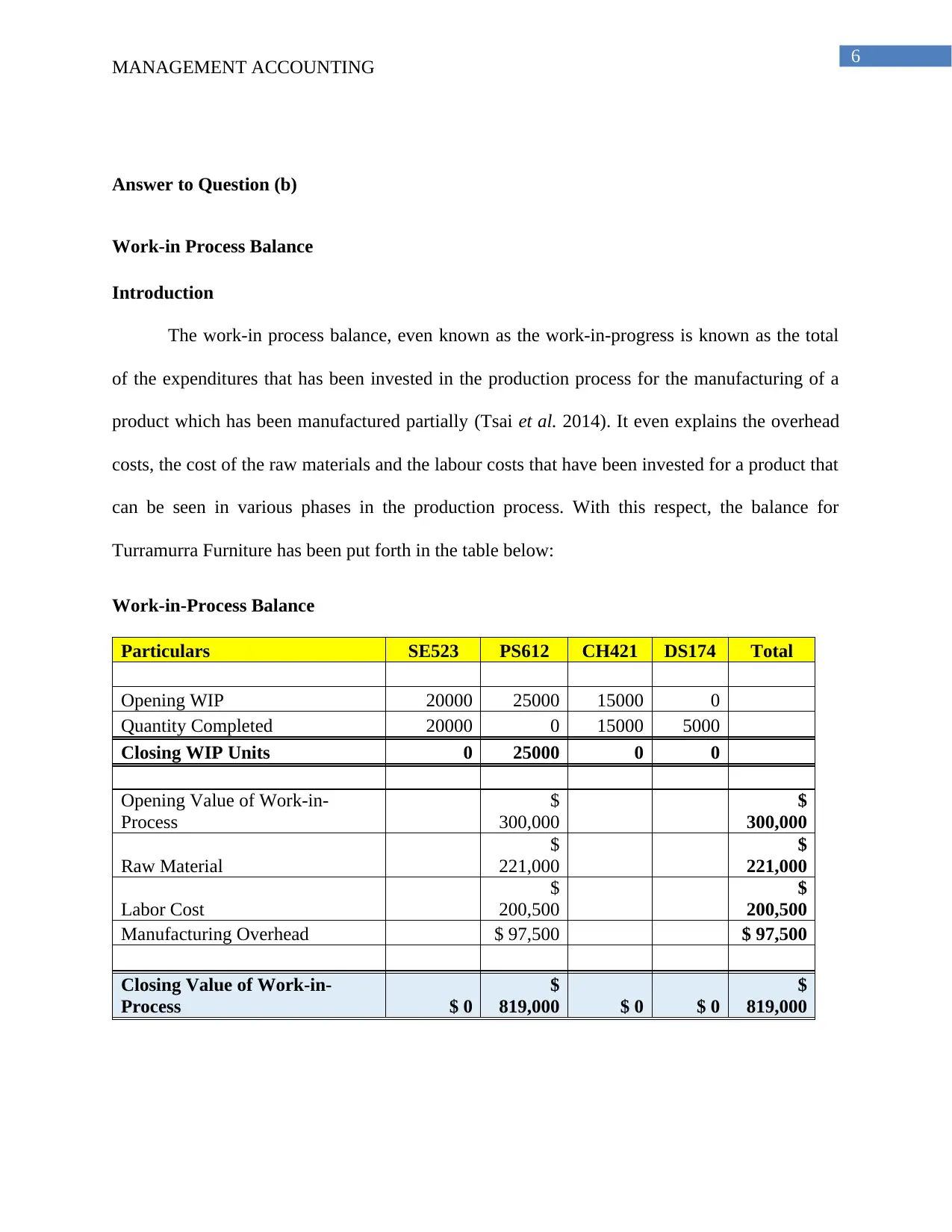
6
MANAGEMENT ACCOUNTING
Answer to Question (b)
Work-in Process Balance
Introduction
The work-in process balance, even known as the work-in-progress is known as the total
of the expenditures that has been invested in the production process for the manufacturing of a
product which has been manufactured partially (Tsai et al. 2014). It even explains the overhead
costs, the cost of the raw materials and the labour costs that have been invested for a product that
can be seen in various phases in the production process. With this respect, the balance for
Turramurra Furniture has been put forth in the table below:
Work-in-Process Balance
Particulars SE523 PS612 CH421 DS174 Total
Opening WIP 20000 25000 15000 0
Quantity Completed 20000 0 15000 5000
Closing WIP Units 0 25000 0 0
Opening Value of Work-in-
Process
$
300,000
$
300,000
Raw Material
$
221,000
$
221,000
Labor Cost
$
200,500
$
200,500
Manufacturing Overhead $ 97,500 $ 97,500
Closing Value of Work-in-
Process $ 0
$
819,000 $ 0 $ 0
$
819,000
MANAGEMENT ACCOUNTING
Answer to Question (b)
Work-in Process Balance
Introduction
The work-in process balance, even known as the work-in-progress is known as the total
of the expenditures that has been invested in the production process for the manufacturing of a
product which has been manufactured partially (Tsai et al. 2014). It even explains the overhead
costs, the cost of the raw materials and the labour costs that have been invested for a product that
can be seen in various phases in the production process. With this respect, the balance for
Turramurra Furniture has been put forth in the table below:
Work-in-Process Balance
Particulars SE523 PS612 CH421 DS174 Total
Opening WIP 20000 25000 15000 0
Quantity Completed 20000 0 15000 5000
Closing WIP Units 0 25000 0 0
Opening Value of Work-in-
Process
$
300,000
$
300,000
Raw Material
$
221,000
$
221,000
Labor Cost
$
200,500
$
200,500
Manufacturing Overhead $ 97,500 $ 97,500
Closing Value of Work-in-
Process $ 0
$
819,000 $ 0 $ 0
$
819,000
Paraphrase This Document
Need a fresh take? Get an instant paraphrase of this document with our AI Paraphraser
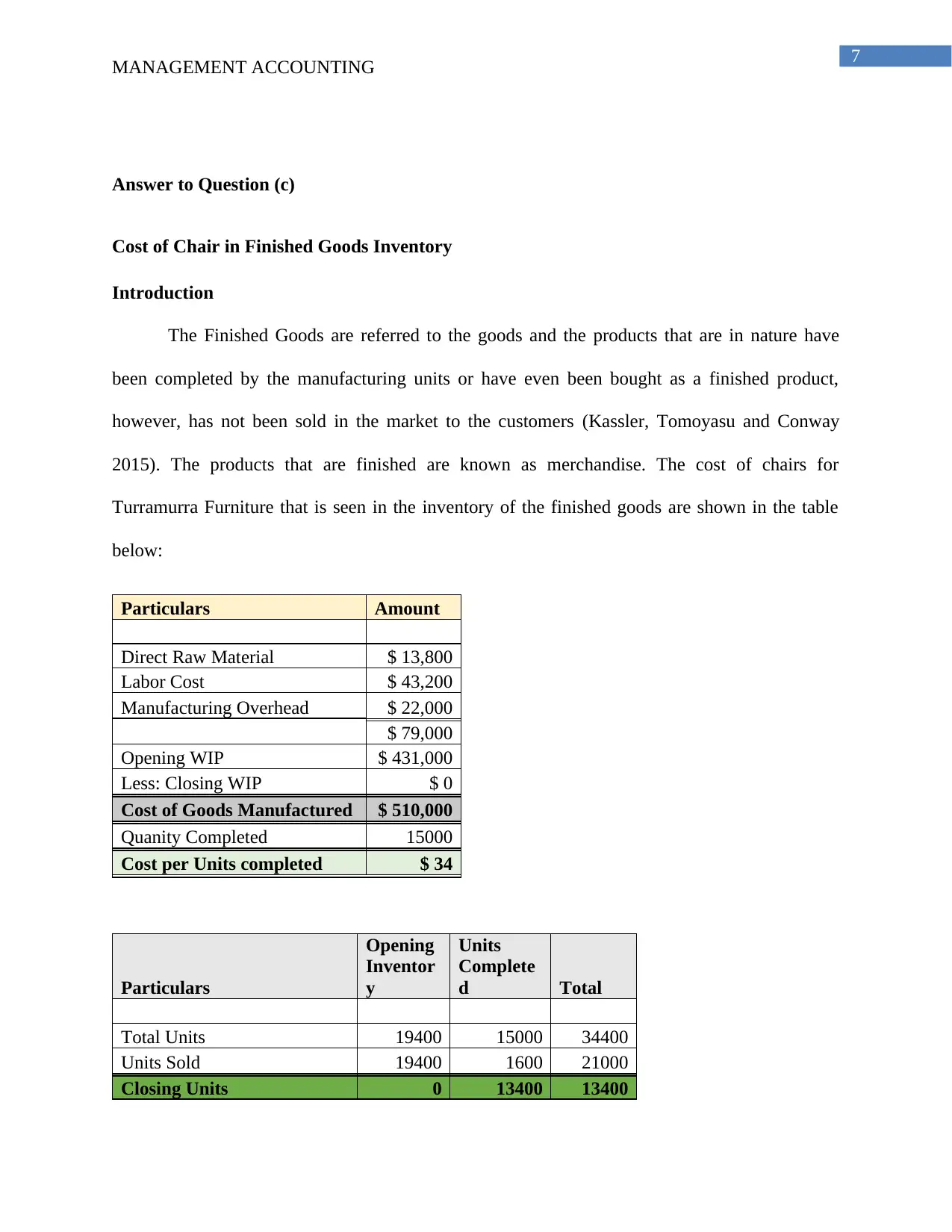
7
MANAGEMENT ACCOUNTING
Answer to Question (c)
Cost of Chair in Finished Goods Inventory
Introduction
The Finished Goods are referred to the goods and the products that are in nature have
been completed by the manufacturing units or have even been bought as a finished product,
however, has not been sold in the market to the customers (Kassler, Tomoyasu and Conway
2015). The products that are finished are known as merchandise. The cost of chairs for
Turramurra Furniture that is seen in the inventory of the finished goods are shown in the table
below:
Particulars Amount
Direct Raw Material $ 13,800
Labor Cost $ 43,200
Manufacturing Overhead $ 22,000
$ 79,000
Opening WIP $ 431,000
Less: Closing WIP $ 0
Cost of Goods Manufactured $ 510,000
Quanity Completed 15000
Cost per Units completed $ 34
Particulars
Opening
Inventor
y
Units
Complete
d Total
Total Units 19400 15000 34400
Units Sold 19400 1600 21000
Closing Units 0 13400 13400
MANAGEMENT ACCOUNTING
Answer to Question (c)
Cost of Chair in Finished Goods Inventory
Introduction
The Finished Goods are referred to the goods and the products that are in nature have
been completed by the manufacturing units or have even been bought as a finished product,
however, has not been sold in the market to the customers (Kassler, Tomoyasu and Conway
2015). The products that are finished are known as merchandise. The cost of chairs for
Turramurra Furniture that is seen in the inventory of the finished goods are shown in the table
below:
Particulars Amount
Direct Raw Material $ 13,800
Labor Cost $ 43,200
Manufacturing Overhead $ 22,000
$ 79,000
Opening WIP $ 431,000
Less: Closing WIP $ 0
Cost of Goods Manufactured $ 510,000
Quanity Completed 15000
Cost per Units completed $ 34
Particulars
Opening
Inventor
y
Units
Complete
d Total
Total Units 19400 15000 34400
Units Sold 19400 1600 21000
Closing Units 0 13400 13400
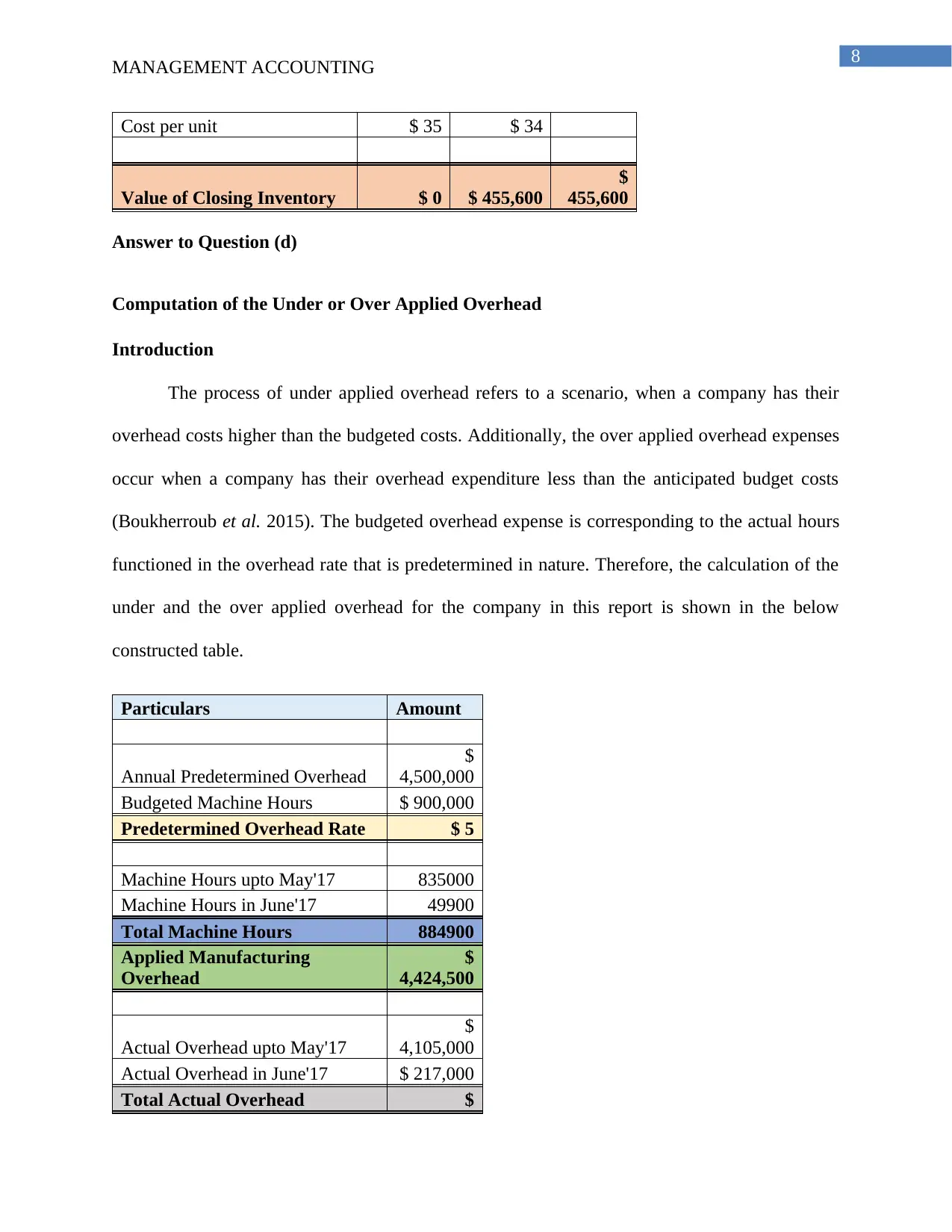
8
MANAGEMENT ACCOUNTING
Cost per unit $ 35 $ 34
Value of Closing Inventory $ 0 $ 455,600
$
455,600
Answer to Question (d)
Computation of the Under or Over Applied Overhead
Introduction
The process of under applied overhead refers to a scenario, when a company has their
overhead costs higher than the budgeted costs. Additionally, the over applied overhead expenses
occur when a company has their overhead expenditure less than the anticipated budget costs
(Boukherroub et al. 2015). The budgeted overhead expense is corresponding to the actual hours
functioned in the overhead rate that is predetermined in nature. Therefore, the calculation of the
under and the over applied overhead for the company in this report is shown in the below
constructed table.
Particulars Amount
Annual Predetermined Overhead
$
4,500,000
Budgeted Machine Hours $ 900,000
Predetermined Overhead Rate $ 5
Machine Hours upto May'17 835000
Machine Hours in June'17 49900
Total Machine Hours 884900
Applied Manufacturing
Overhead
$
4,424,500
Actual Overhead upto May'17
$
4,105,000
Actual Overhead in June'17 $ 217,000
Total Actual Overhead $
MANAGEMENT ACCOUNTING
Cost per unit $ 35 $ 34
Value of Closing Inventory $ 0 $ 455,600
$
455,600
Answer to Question (d)
Computation of the Under or Over Applied Overhead
Introduction
The process of under applied overhead refers to a scenario, when a company has their
overhead costs higher than the budgeted costs. Additionally, the over applied overhead expenses
occur when a company has their overhead expenditure less than the anticipated budget costs
(Boukherroub et al. 2015). The budgeted overhead expense is corresponding to the actual hours
functioned in the overhead rate that is predetermined in nature. Therefore, the calculation of the
under and the over applied overhead for the company in this report is shown in the below
constructed table.
Particulars Amount
Annual Predetermined Overhead
$
4,500,000
Budgeted Machine Hours $ 900,000
Predetermined Overhead Rate $ 5
Machine Hours upto May'17 835000
Machine Hours in June'17 49900
Total Machine Hours 884900
Applied Manufacturing
Overhead
$
4,424,500
Actual Overhead upto May'17
$
4,105,000
Actual Overhead in June'17 $ 217,000
Total Actual Overhead $
⊘ This is a preview!⊘
Do you want full access?
Subscribe today to unlock all pages.

Trusted by 1+ million students worldwide
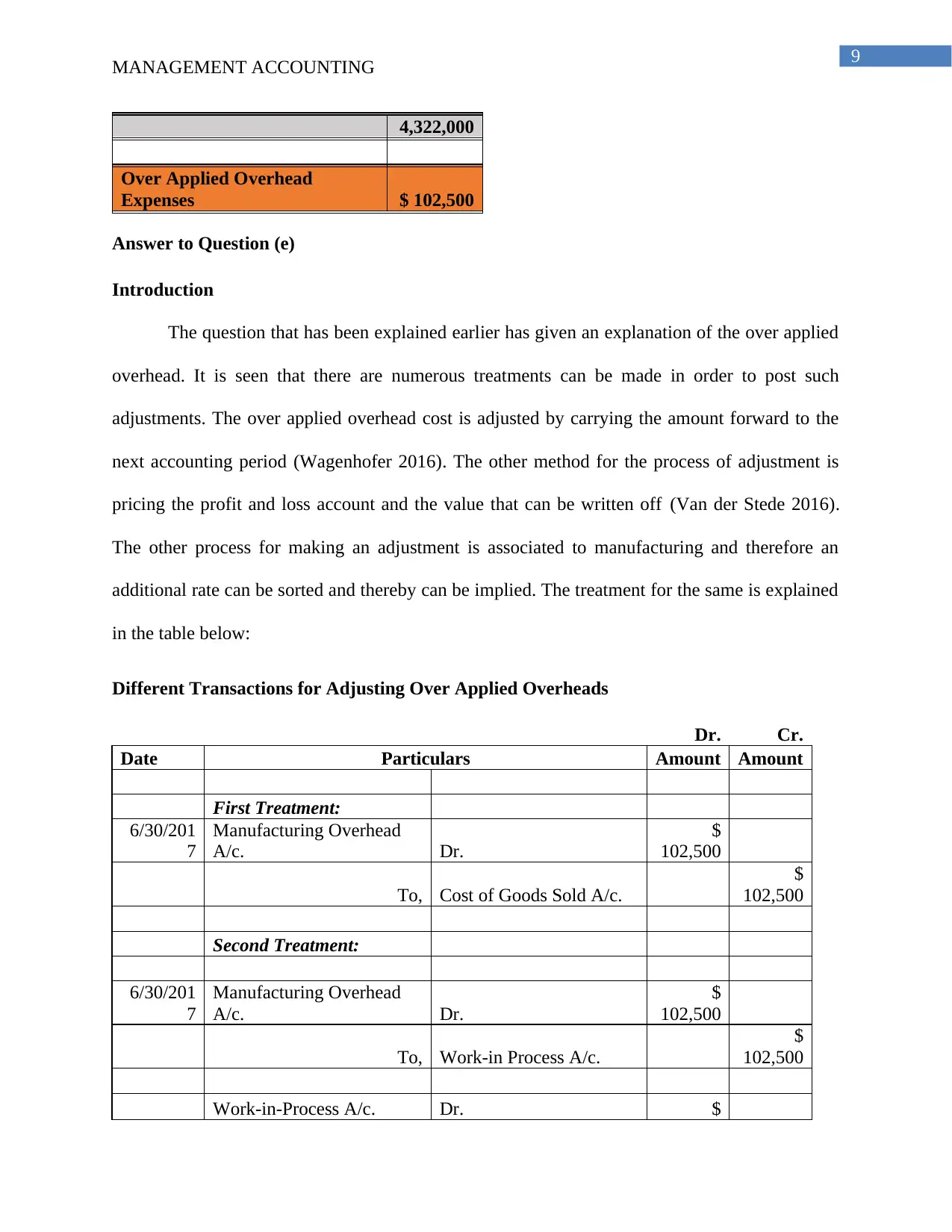
9
MANAGEMENT ACCOUNTING
4,322,000
Over Applied Overhead
Expenses $ 102,500
Answer to Question (e)
Introduction
The question that has been explained earlier has given an explanation of the over applied
overhead. It is seen that there are numerous treatments can be made in order to post such
adjustments. The over applied overhead cost is adjusted by carrying the amount forward to the
next accounting period (Wagenhofer 2016). The other method for the process of adjustment is
pricing the profit and loss account and the value that can be written off (Van der Stede 2016).
The other process for making an adjustment is associated to manufacturing and therefore an
additional rate can be sorted and thereby can be implied. The treatment for the same is explained
in the table below:
Different Transactions for Adjusting Over Applied Overheads
Dr. Cr.
Date Particulars Amount Amount
First Treatment:
6/30/201
7
Manufacturing Overhead
A/c. Dr.
$
102,500
To, Cost of Goods Sold A/c.
$
102,500
Second Treatment:
6/30/201
7
Manufacturing Overhead
A/c. Dr.
$
102,500
To, Work-in Process A/c.
$
102,500
Work-in-Process A/c. Dr. $
MANAGEMENT ACCOUNTING
4,322,000
Over Applied Overhead
Expenses $ 102,500
Answer to Question (e)
Introduction
The question that has been explained earlier has given an explanation of the over applied
overhead. It is seen that there are numerous treatments can be made in order to post such
adjustments. The over applied overhead cost is adjusted by carrying the amount forward to the
next accounting period (Wagenhofer 2016). The other method for the process of adjustment is
pricing the profit and loss account and the value that can be written off (Van der Stede 2016).
The other process for making an adjustment is associated to manufacturing and therefore an
additional rate can be sorted and thereby can be implied. The treatment for the same is explained
in the table below:
Different Transactions for Adjusting Over Applied Overheads
Dr. Cr.
Date Particulars Amount Amount
First Treatment:
6/30/201
7
Manufacturing Overhead
A/c. Dr.
$
102,500
To, Cost of Goods Sold A/c.
$
102,500
Second Treatment:
6/30/201
7
Manufacturing Overhead
A/c. Dr.
$
102,500
To, Work-in Process A/c.
$
102,500
Work-in-Process A/c. Dr. $
Paraphrase This Document
Need a fresh take? Get an instant paraphrase of this document with our AI Paraphraser
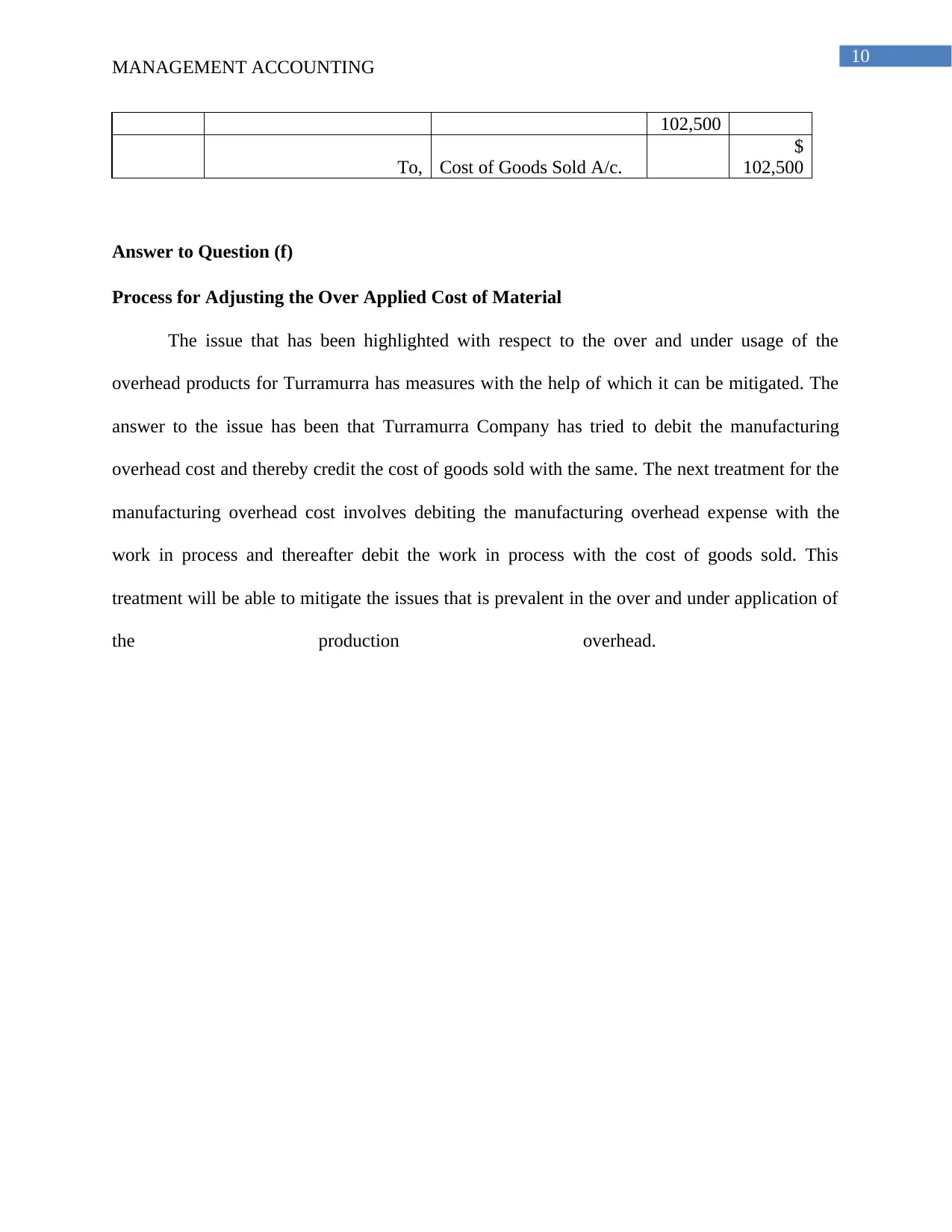
10
MANAGEMENT ACCOUNTING
102,500
To, Cost of Goods Sold A/c.
$
102,500
Answer to Question (f)
Process for Adjusting the Over Applied Cost of Material
The issue that has been highlighted with respect to the over and under usage of the
overhead products for Turramurra has measures with the help of which it can be mitigated. The
answer to the issue has been that Turramurra Company has tried to debit the manufacturing
overhead cost and thereby credit the cost of goods sold with the same. The next treatment for the
manufacturing overhead cost involves debiting the manufacturing overhead expense with the
work in process and thereafter debit the work in process with the cost of goods sold. This
treatment will be able to mitigate the issues that is prevalent in the over and under application of
the production overhead.
MANAGEMENT ACCOUNTING
102,500
To, Cost of Goods Sold A/c.
$
102,500
Answer to Question (f)
Process for Adjusting the Over Applied Cost of Material
The issue that has been highlighted with respect to the over and under usage of the
overhead products for Turramurra has measures with the help of which it can be mitigated. The
answer to the issue has been that Turramurra Company has tried to debit the manufacturing
overhead cost and thereby credit the cost of goods sold with the same. The next treatment for the
manufacturing overhead cost involves debiting the manufacturing overhead expense with the
work in process and thereafter debit the work in process with the cost of goods sold. This
treatment will be able to mitigate the issues that is prevalent in the over and under application of
the production overhead.
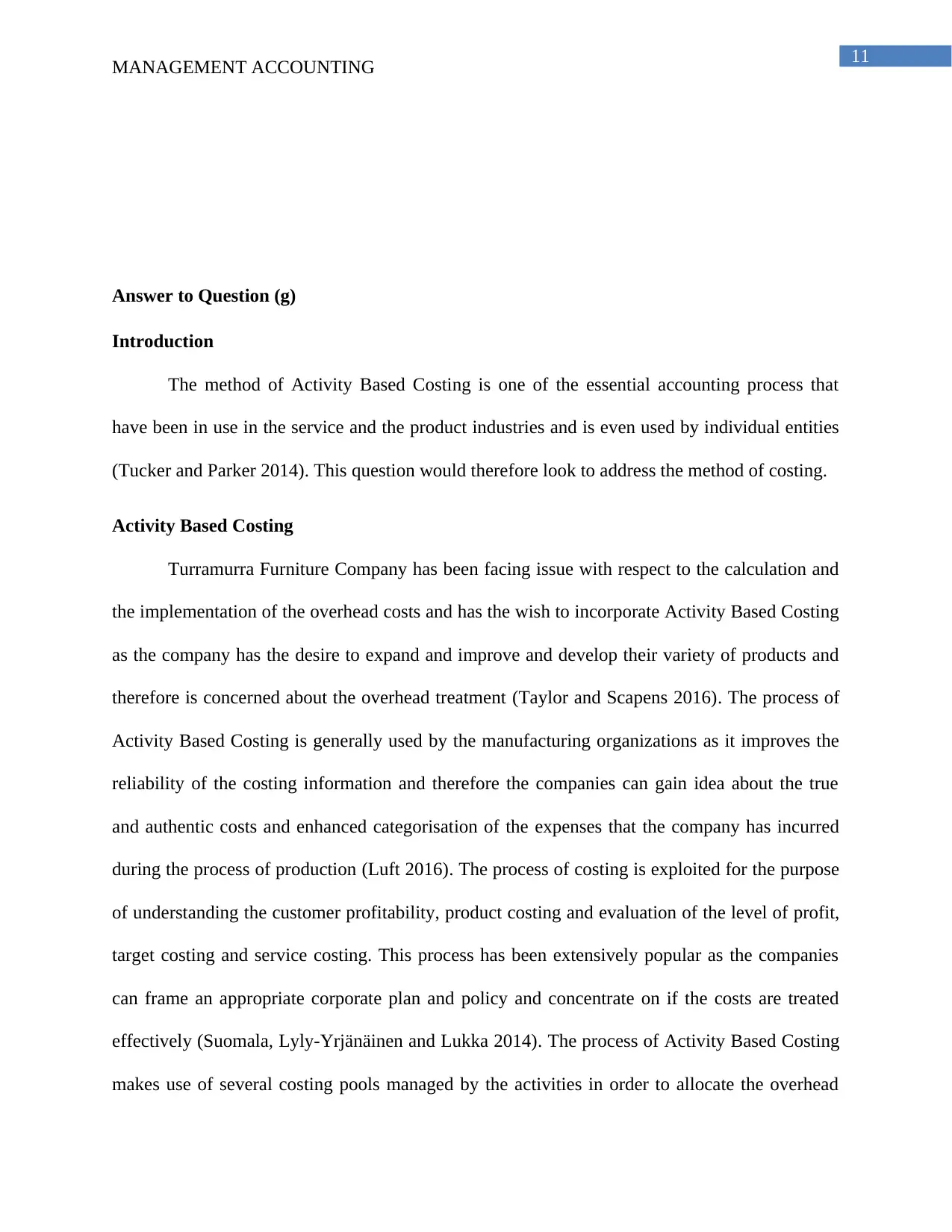
11
MANAGEMENT ACCOUNTING
Answer to Question (g)
Introduction
The method of Activity Based Costing is one of the essential accounting process that
have been in use in the service and the product industries and is even used by individual entities
(Tucker and Parker 2014). This question would therefore look to address the method of costing.
Activity Based Costing
Turramurra Furniture Company has been facing issue with respect to the calculation and
the implementation of the overhead costs and has the wish to incorporate Activity Based Costing
as the company has the desire to expand and improve and develop their variety of products and
therefore is concerned about the overhead treatment (Taylor and Scapens 2016). The process of
Activity Based Costing is generally used by the manufacturing organizations as it improves the
reliability of the costing information and therefore the companies can gain idea about the true
and authentic costs and enhanced categorisation of the expenses that the company has incurred
during the process of production (Luft 2016). The process of costing is exploited for the purpose
of understanding the customer profitability, product costing and evaluation of the level of profit,
target costing and service costing. This process has been extensively popular as the companies
can frame an appropriate corporate plan and policy and concentrate on if the costs are treated
effectively (Suomala, Lyly-Yrjänäinen and Lukka 2014). The process of Activity Based Costing
makes use of several costing pools managed by the activities in order to allocate the overhead
MANAGEMENT ACCOUNTING
Answer to Question (g)
Introduction
The method of Activity Based Costing is one of the essential accounting process that
have been in use in the service and the product industries and is even used by individual entities
(Tucker and Parker 2014). This question would therefore look to address the method of costing.
Activity Based Costing
Turramurra Furniture Company has been facing issue with respect to the calculation and
the implementation of the overhead costs and has the wish to incorporate Activity Based Costing
as the company has the desire to expand and improve and develop their variety of products and
therefore is concerned about the overhead treatment (Taylor and Scapens 2016). The process of
Activity Based Costing is generally used by the manufacturing organizations as it improves the
reliability of the costing information and therefore the companies can gain idea about the true
and authentic costs and enhanced categorisation of the expenses that the company has incurred
during the process of production (Luft 2016). The process of costing is exploited for the purpose
of understanding the customer profitability, product costing and evaluation of the level of profit,
target costing and service costing. This process has been extensively popular as the companies
can frame an appropriate corporate plan and policy and concentrate on if the costs are treated
effectively (Suomala, Lyly-Yrjänäinen and Lukka 2014). The process of Activity Based Costing
makes use of several costing pools managed by the activities in order to allocate the overhead
⊘ This is a preview!⊘
Do you want full access?
Subscribe today to unlock all pages.

Trusted by 1+ million students worldwide
1 out of 17
Related Documents
Your All-in-One AI-Powered Toolkit for Academic Success.
+13062052269
info@desklib.com
Available 24*7 on WhatsApp / Email
![[object Object]](/_next/static/media/star-bottom.7253800d.svg)
Unlock your academic potential
Copyright © 2020–2025 A2Z Services. All Rights Reserved. Developed and managed by ZUCOL.





